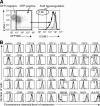Stable isotope labeling by amino acids in cell culture and differential plasma membrane proteome quantitation identify new substrates for the MARCH9 transmembrane E3 ligase
- PMID: 19457934
- PMCID: PMC2722766
- DOI: 10.1074/mcp.M900174-MCP200
Stable isotope labeling by amino acids in cell culture and differential plasma membrane proteome quantitation identify new substrates for the MARCH9 transmembrane E3 ligase
Abstract
The regulation of cell surface receptor expression is essential for immune cell differentiation and function. At the plasma membrane ubiquitination is an important post-translational mechanism for regulating expression of a wide range of surface proteins. MARCH9, a member of the RING-CH family of transmembrane E3 ubiquitin ligases, down-regulates CD4, major histocompatibility complex-I (MHC), and ICAM-1 in lymphoid cells. To identify novel MARCH9 substrates, we used high throughput flow cytometry and quantitative mass spectrometry by stable isotope labeling by amino acids in cell culture (SILAC) to determine the differential expression of plasma membrane proteins in a MARCH9-expressing B cell line. This combined approach identified 13 potential new MARCH9 targets. All of the SILAC-identified targets for which antibodies were available were subsequently confirmed by flow cytometry, validating the proteomics results. A close correlation (r(2) = 0.93) between -fold down-regulation as determined by SILAC and flow cytometry was found, with no false positive hits detected. The potential new MARCH9 substrates cover a wide range of functions and include receptor-type protein-tyrosine phosphatases (e.g. PTPRJ/CD148) as well as Fc gamma receptor IIB (CD32B), HLA-DQ, signaling lymphocytic activation molecule (CD150), and polio virus receptor (CD155). The identification of plasma membrane targets by SILAC with confirmation by flow cytometry represents a novel and powerful approach to analyze changes in the plasma membrane proteome.
Figures





Similar articles
-
A serine in the first transmembrane domain of the human E3 ubiquitin ligase MARCH9 is critical for down-regulation of its protein substrates.J Biol Chem. 2019 Feb 15;294(7):2470-2485. doi: 10.1074/jbc.RA118.004836. Epub 2018 Dec 15. J Biol Chem. 2019. PMID: 30554144 Free PMC article.
-
Quantitative proteomics using stable isotope labeling with amino acids in cell culture.Nat Protoc. 2008;3(3):505-16. doi: 10.1038/nprot.2008.2. Nat Protoc. 2008. PMID: 18323819
-
Stress-regulated targeting of the NKG2D ligand Mult1 by a membrane-associated RING-CH family E3 ligase.J Immunol. 2010 Nov 1;185(9):5369-76. doi: 10.4049/jimmunol.1000247. Epub 2010 Sep 24. J Immunol. 2010. PMID: 20870941 Free PMC article.
-
Stable isotope labeling by amino acids in cell culture (SILAC) for quantitative proteomics.Adv Exp Med Biol. 2014;806:93-106. doi: 10.1007/978-3-319-06068-2_5. Adv Exp Med Biol. 2014. PMID: 24952180 Review.
-
Stable Isotope Labeling by Amino Acids in Cell Culture (SILAC) for Quantitative Proteomics.Adv Exp Med Biol. 2019;1140:531-539. doi: 10.1007/978-3-030-15950-4_31. Adv Exp Med Biol. 2019. PMID: 31347069 Review.
Cited by
-
E3Net: a system for exploring E3-mediated regulatory networks of cellular functions.Mol Cell Proteomics. 2012 Apr;11(4):O111.014076. doi: 10.1074/mcp.O111.014076. Epub 2011 Dec 22. Mol Cell Proteomics. 2012. PMID: 22199232 Free PMC article.
-
FcgammaRIIB in autoimmunity and infection: evolutionary and therapeutic implications.Nat Rev Immunol. 2010 May;10(5):328-43. doi: 10.1038/nri2762. Nat Rev Immunol. 2010. PMID: 20414206 Free PMC article. Review.
-
Systematic approaches to identify E3 ligase substrates.Biochem J. 2016 Nov 15;473(22):4083-4101. doi: 10.1042/BCJ20160719. Biochem J. 2016. PMID: 27834739 Free PMC article. Review.
-
Haploid genetic screens identify an essential role for PLP2 in the downregulation of novel plasma membrane targets by viral E3 ubiquitin ligases.PLoS Pathog. 2013;9(11):e1003772. doi: 10.1371/journal.ppat.1003772. Epub 2013 Nov 21. PLoS Pathog. 2013. PMID: 24278019 Free PMC article.
-
Degronomics: Mapping the Interacting Peptidome of a Ubiquitin Ligase Using an Integrative Mass Spectrometry Strategy.Anal Chem. 2019 Oct 15;91(20):12775-12783. doi: 10.1021/acs.analchem.9b02331. Epub 2019 Sep 26. Anal Chem. 2019. PMID: 31525912 Free PMC article.
References
-
- Staub O., Rotin D. ( 2006) Role of ubiquitylation in cellular membrane transport. Physiol. Rev. 86, 669– 707 - PubMed
-
- Liu Y. C. ( 2004) Ubiquitin ligases and the immune response. Annu. Rev. Immunol. 22, 81– 127 - PubMed
-
- Zola H., Swart B., Banham A., Barry S., Beare A., Bensussan A., Boumsell L., Buckley C. D., Bühring H. J., Clark G., Engel P., Fox D., Jin B. Q., Macardle P. J., Malavasi F., Mason D., Stockinger H., Yang X. ( 2007) CD molecules 2006–human cell differentiation molecules. J. Immunol. Methods 319, 1– 5 - PubMed
-
- Arkin I. T., Brunger A. T. ( 1998) Statistical analysis of predicted transmembrane alpha-helices. Biochim. Biophys. Acta 1429, 113– 128 - PubMed
-
- Naramura M., Jang I. K., Kole H., Huang F., Haines D., Gu H. ( 2002) c-Cbl and Cbl-b regulate T cell responsiveness by promoting ligand-induced TCR down-modulation. Nat. Immunol. 3, 1192– 1199 - PubMed
Publication types
MeSH terms
Substances
Grants and funding
LinkOut - more resources
Full Text Sources
Research Materials
Miscellaneous

